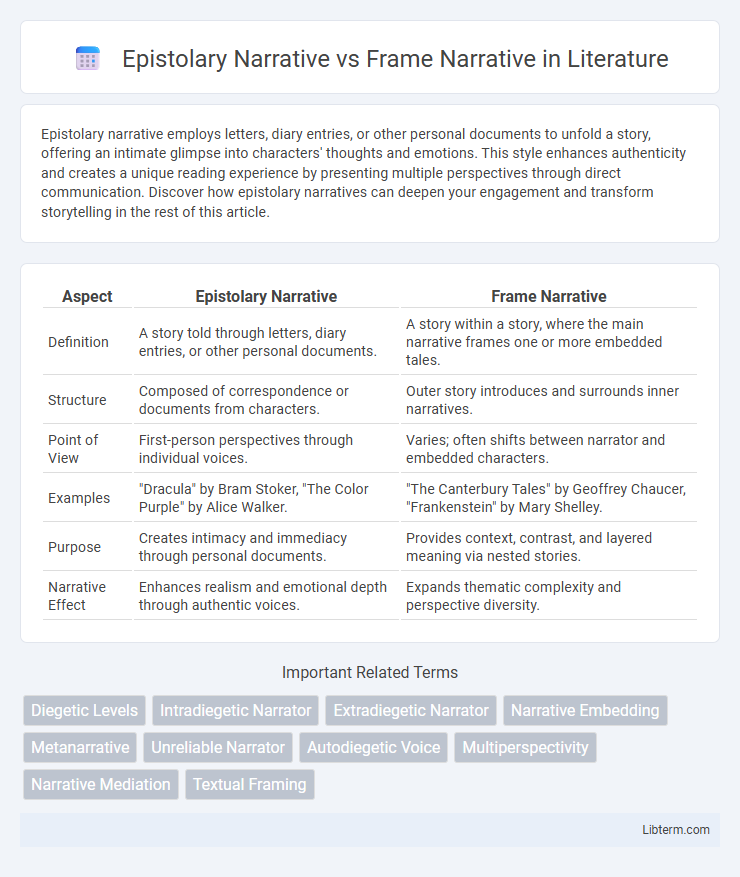Epistolary narrative employs letters, diary entries, or other personal documents to unfold a story, offering an intimate glimpse into characters' thoughts and emotions. This style enhances authenticity and creates a unique reading experience by presenting multiple perspectives through direct communication. Discover how epistolary narratives can deepen your engagement and transform storytelling in the rest of this article.
Table of Comparison
| Aspect | Epistolary Narrative | Frame Narrative |
|---|---|---|
| Definition | A story told through letters, diary entries, or other personal documents. | A story within a story, where the main narrative frames one or more embedded tales. |
| Structure | Composed of correspondence or documents from characters. | Outer story introduces and surrounds inner narratives. |
| Point of View | First-person perspectives through individual voices. | Varies; often shifts between narrator and embedded characters. |
| Examples | "Dracula" by Bram Stoker, "The Color Purple" by Alice Walker. | "The Canterbury Tales" by Geoffrey Chaucer, "Frankenstein" by Mary Shelley. |
| Purpose | Creates intimacy and immediacy through personal documents. | Provides context, contrast, and layered meaning via nested stories. |
| Narrative Effect | Enhances realism and emotional depth through authentic voices. | Expands thematic complexity and perspective diversity. |
Introduction to Narrative Structures
Epistolary narrative utilizes letters, diary entries, or other personal documents to reveal character perspectives and advance the plot, creating an intimate and subjective storytelling experience. Frame narrative encloses a main story within an overarching narrative, providing context and multiple layers of meaning by embedding one or more stories inside a larger one. Both structures enhance thematic depth and engage readers through distinct methods of organizing and presenting narrative content.
Defining Epistolary Narrative
Epistolary narrative is a literary technique where the story unfolds through a series of letters, diary entries, or other personal documents, allowing intimate access to characters' thoughts and emotions. This format enhances authenticity and emotional depth by presenting multiple perspectives within the correspondence. Unlike frame narrative, which uses a story within a story to provide context or background, epistolary narrative relies on direct, personal communication as the primary storytelling vehicle.
Understanding Frame Narrative
Frame narrative is a literary technique where a main story encloses one or more embedded stories, providing context and deeper meaning to the overall text. This structure allows authors to present multiple perspectives and layers of storytelling, often enhancing thematic complexity and character development. Understanding frame narrative involves recognizing how the outer story shapes the interpretation of the inner narratives and creates a cohesive literary experience.
Historical Origins and Evolution
Epistolary narrative, emerging prominently in 18th-century literature, exploits letters to convey characters' thoughts and plot, reflecting intimate and personal communication rooted in the rise of literacy and postal systems. Frame narrative, with ancient origins in works like Scheherazade's "One Thousand and One Nights," uses a story within a story to structure complex tales, preserving oral traditions and enhancing thematic depth. Both forms evolved to adapt to changing literary tastes, with epistolary novels emphasizing authenticity and immediacy, while frame narratives provide layered storytelling and diverse perspectives.
Key Characteristics of Epistolary Narratives
Epistolary narratives are distinguished by their use of letters, diary entries, or other personal documents as the primary mode of storytelling, providing intimate insights into characters' thoughts and emotions. This narrative style enhances authenticity and immediacy by presenting multiple perspectives directly through the characters' own voices. The fragmented structure of epistolary narratives allows for a layered, subjective experience, often creating suspense and deeper emotional engagement.
Essential Features of Frame Narratives
Frame narratives consist of a primary story that sets the stage for one or more embedded stories, creating a layered storytelling structure. Essential features include a defined narrative boundary, where the outer story provides context and perspective for the inner tales, often enhancing thematic depth and character development. This structure allows multiple viewpoints and temporal shifts, enriching the reader's understanding through interconnected narratives.
Comparative Analysis: Epistolary vs. Frame
Epistolary narratives utilize letters or diary entries to convey characters' intimate thoughts and maintain a subjective, fragmented perspective, enhancing emotional depth and immediacy. Frame narratives embed a story within another story, offering multiple viewpoints and a structured context that guides the reader through layered meanings and temporal shifts. Comparative analysis reveals epistolary forms emphasize personal authenticity and direct voice, while frame narratives prioritize thematic complexity and narrative cohesion.
Notable Examples in Literature
Epistolary narrative is exemplified in Mary Shelley's "Frankenstein," where the story unfolds through letters, creating intimate and subjective perspectives. Frame narrative is illustrated by Geoffrey Chaucer's "The Canterbury Tales," weaving multiple interconnected stories within a larger storytelling context. Both techniques enhance storytelling by providing layered viewpoints and deepening reader engagement through structural complexity.
Impact on Reader Engagement and Perspective
Epistolary narratives deepen reader engagement by offering intimate, firsthand perspectives through letters, diary entries, or emails, fostering a personal connection with characters' emotions and thoughts. Frame narratives broaden perspective by embedding multiple stories within an overarching context, enhancing thematic complexity and encouraging readers to analyze relationships between different narrative layers. Both techniques manipulate narrative distance, with epistolary form creating immediacy and frame narrative promoting reflective engagement.
Choosing the Right Structure for Your Story
Choosing between epistolary narrative and frame narrative hinges on the desired reader experience and story complexity. Epistolary narratives, composed of letters, diary entries, or emails, create intimacy and immediacy, allowing deep emotional connection through first-person perspectives. Frame narratives, embedding one or more stories within a larger story, offer layered context and thematic depth, ideal for exploring multiple viewpoints or time periods within a cohesive structure.
Epistolary Narrative Infographic

 libterm.com
libterm.com